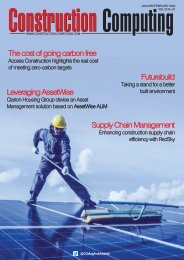Create successful ePaper yourself
Turn your PDF publications into a flip-book with our unique Google optimized e-Paper software.
TECHNOLOGY: AI Dm<br />
RECOGNITION IS LIMITED<br />
To date, a vast amount has been invested<br />
deploying traditional recognition<br />
technologies such OCR, ICR and intelligent<br />
word recognition to analyse the content of<br />
documents and boost automation. It's still<br />
very much a growth area. Research shows<br />
that the global OCR market is expected to<br />
reach $13.38 billion by 2025 - increasing<br />
at a CAGR of 13.7% from 2019.<br />
Despite this, there are limitations. Many<br />
ICR/OCR engines struggle to process a mix<br />
of documents - encompassing structured,<br />
semi-structured and unstructured data -<br />
along with cursive handwriting, historical<br />
and old documents especially when the<br />
legibility of the paperwork is poor. The<br />
situation is exacerbated when volumes are<br />
high. And no one traditional ICR/OCR<br />
engine can seamlessly process a variety of<br />
languages - jumping from documents in<br />
English to Chinese, German and so on.<br />
With such variability, correct read-rates<br />
drop markedly - it's still tough to get<br />
more than 90-95% accuracy today - such<br />
that staff are required to then manually<br />
re-key information in. This is time<br />
consuming, costly and begs the question<br />
of whether enough trained employees<br />
are available to do it.<br />
Of course, crowdsourcing approaches are<br />
a good and cheaper work around than<br />
actually hiring people to enhance accuracy.<br />
Snippets of data are sent to online entry<br />
clerks logged into an Internet-based system<br />
who then check it prior to inputting it into<br />
line of business systems.<br />
But the promise - and now reality - of AI<br />
is that these challenges are also resolved<br />
using powerful cognitive systems.<br />
AI-POWERED SOLUTIONS ARE<br />
ALREADY HERE<br />
Utilising neural networks, AI-driven<br />
document processing platforms offer a<br />
leapfrog advance over traditional<br />
recognition technologies. At the outset, a<br />
system is 'trained' so that a consolidated<br />
core knowledge base is created about a<br />
particular (spoken) language, form and/or<br />
document type. In AI jargon, this is<br />
known as the 'inference'. This knowledge<br />
base then expands and grows over time<br />
as more and more information is fed into<br />
the system and it self-learns - able to<br />
recognise documents and their contents<br />
as they arrive.<br />
This is achieved using a feedback 'retraining<br />
loop' - think of it as supervised<br />
learning overseen by a human -<br />
whereby errors in the system are<br />
corrected when they arise so that the<br />
inference (and the metadata underlying<br />
it) updates, learns and is able to then<br />
deal with similar situations on its own<br />
when they next appear.<br />
It's not dissimilar to how the human brain<br />
works, for example how children learn a<br />
language. The more kids talk, make<br />
mistakes and are corrected, the better they<br />
get at speaking. The same is true with AI<br />
when applied to document analysis and<br />
processing. The inference becomes ever<br />
more knowledgeable and accurate.<br />
AI-based systems can be trained to<br />
automatically recognise specific forms,<br />
review specific content and its layout on<br />
the page and then convert cursive<br />
handwriting into standard electronic<br />
formats such as PDF or JSON for analysis or<br />
workflow purposes, with validation and<br />
verification also taking place. This can also<br />
be done at a field-based level so that key<br />
value extraction can be completed.<br />
Admittedly this is something that ICR/OCR<br />
systems can also do but they struggle to<br />
recognise cursive handwriting and require<br />
complex algorithms to find the fields.<br />
Key value extraction on a form, for<br />
example, could be a generic box for 'name'<br />
or 'age' - the key - and then the specific<br />
values would be 'Mr John Smith' and '50'.<br />
Or on an invoice, the keys are items<br />
purchased and the values are the prices<br />
paid for each different one.<br />
The benefits here are clear. Governments,<br />
healthcare providers, banks and insurance<br />
firms have to process a vast number of<br />
handwritten forms with identical formats<br />
for various purposes like questionnaires,<br />
applications, personal loans, mortgages or<br />
claims. Retrieving the handwritten<br />
information from them and converting it<br />
into a digital format without human<br />
intervention reduces manual errors, lowers<br />
cost, allows big data analytics and makes<br />
turnaround considerably faster.<br />
And the speed of this AI-based processing<br />
is impressive. Anywhere up to 50,000<br />
pages per hour can be completed using a<br />
single server, with bigger deployments and<br />
cloud delivery also possible when more<br />
compute power is added.<br />
Multiple different common files can be<br />
ingested for analysis such as plain text, PDF,<br />
TIFF, JPEG, GIF, PPM, PNG and so on with<br />
several neural nets then reading the text<br />
and classifying the type - whether it be<br />
handwriting or machine print - with 'fuzzy<br />
search' aiding the text-to-digital conversion<br />
process. And class-leading AI systems, in<br />
addition to handling paper documents, are<br />
designed to cope with pictures, video and<br />
audio, too. Put another way, they are<br />
content-agnostic and can handle any<br />
source content.<br />
AI IN PRACTICE<br />
This is real stuff. One German insurance<br />
firm is working over the next six years to<br />
shift its entire claim process to use an AIpowered<br />
system such that claims under a<br />
certain value will be handled automatically<br />
based on information extracted, assessed<br />
and approved from a form with no human<br />
involvement required at all. This will be<br />
accomplished as the AI solution<br />
automatically checks the name, address,<br />
insurance number and other key details<br />
about a given incident - capturing all the<br />
data from the form correctly first time<br />
every time.<br />
When it comes to document processing,<br />
seeing AI in action is impressive. It's magical<br />
stuff to watch a machine 'read' a scanned<br />
paper document and extract data from it.<br />
One of the consequences of the Covid-19<br />
pandemic and the economic fallout from it<br />
is that many companies will want to<br />
improve efficiency in a bid to save money.<br />
Those who have a significant cost and<br />
operational overhead processing forms and<br />
other documentation many feel a sense of<br />
corporate anxiety or even alarm about how<br />
to do this.<br />
As The Hitchhiker's Guide helpfully advised<br />
on its cover, don't panic. AI has sufficiently<br />
matured such that it is now a real-world<br />
performant and reliable option for<br />
companies tasked with grappling and<br />
dealing with millions of paper documents.<br />
More info: www.ibml.com<br />
www.document-manager.com<br />
<strong>Jan</strong>uary/<strong>Feb</strong>ruary <strong>2021</strong><br />
@<strong>DM</strong>MagAndAwards<br />
11

















